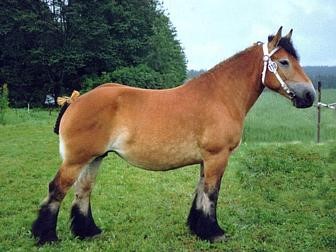Swedish Ardennes horses were developed in Sweden when the
Count C.G. Wrangle brought large Ardennes horses to the country in 1872. By
1880 most parts of south and central Sweden had imported or crossed Ardennes.
These heavier horses were bred with the horse of the Swedish countryside. The
resulting horse was very mobile and marked by longevity. So successful was the
breeding effort that a stud book was opened in 1901.
For years, the wild horse population of Sweden was
indiscriminately crossed with other imported breeds. Even when studs began
focusing their breeding efforts, however, horses were chosen more for their
outer looks than well examined conformation standards. By 1874, this had all
changed and examinations were required for a horse of Swedish Warmblood,
Swedish Ardennes, and North Swedish Horse stock to be entered into a stud book.
They stand around 15 to 16 hands high; they are a medium
built heavy draft breed. Although not exactly distinguished, the horse more
than makes up for this lack through their good health, longevity, and sweet
temper. Their head is heavy with a smallish eye. Their neck is short and thick.
Their back is short, their chest wide, and their shoulders are well muscled.

